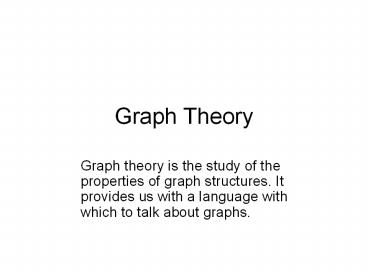Graph Theory - PowerPoint PPT Presentation
1 / 15
Title: Graph Theory
1
Graph Theory
- Graph theory is the study of the properties of
graph structures. It provides us with a language
with which to talk about graphs.
2
Degree
- The degree of a vertex is the number of edges
incident upon it. - The sum of the vertex degrees in any undirected
graph is even (twice the number of edges). - Every graph contains an even number of odd-degree
vertices.
3
Connectivity
- A graph is connected if there is an undirected
path between every pair of vertices. - The existence of a spanning tree is sufficient to
prove connectivity. - The vertex (edge) connectivity is the smallest
number of vertices (edges) which must be deleted
to disconnect the graph.
4
Some terms
- articulation vertex ?? biconnected
- bridge ?? edge-biconnected
- Testing for articulation vertices or bridges is
easy via brute force.
5
Cycles
- Eulerian cycle (path) a tour which visits every
edge of the graph exactly once. - Actually, it is a circuit, not a cycle, because
it may visit vertices more than once. - A mailmans route is ideally an Eulerian cycle,
so he can visit every street (edge) in the
neighborhood once before returning home.
6
- An undirected graph contains an Eulerian cycle if
it is connected and every vertex is of even
degree. - A Hamiltonian cycle is a tour which visits every
vertex of the graph exactly once. - The traveling salesman problem asks for the
shortest such tour on a weighted graph.
7
Planer Graph
- Eulers formulan-mf2
- n of vertices
- m of edges
- f of faces
- Trees mn-1, f1
- Cubes n8, m12, f6
8
MST
- Kruskals algorithmstarting from a minimal
edge - Prims algorithmstarting from a given vertex
- How about maximum spanning tree
- and Minimum Product spanning tree
9
Kruskals Algorithm
- Algorithm Kruskal(G)
- InputG(V, E)??????(undirected weighted
graph),??Vv0,,vn-1 - OutputG??????(minimum spanning tree, MST)
- T?? //T?MST,????????
- while T????n-1?? do
- ???(u, v),??(u, v)?E,?(u, v)???(weight)??
- E?E-(u, v)
- if ( (u, v)??T?????(cycle) ) then ?(u, v)??
- else T?T?(u, v)
- return T
10
Kruskals Algorithm -Construct MST
11
Prims algorithm
- Algorithm Prim(G)
- InputG(V, E)??????(undirected weighted
graph),??Vv0,,vn-1 - OutputG??????(minimum spanning tree, MST)
- T?? //T?MST,????????
- X?vx //????????vx????X?
- while T????n-1?? do
- ??(u, v)?E,??u?X?v?V-X,?(u, v)???(weight)??
- T?T?(u, v)
- X?X?v
- return T
12
(No Transcript)
13
(No Transcript)
14
One-to-all shorted path
- Dijkstra??? Dijkstra???????????(source)?????(dest
ination)??????(one-to-all)???????
15
All-pair shortest path
- Floyd-Warshall??????????(all-pair shortest
path)???































